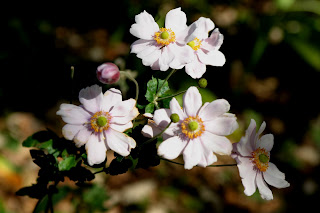Since the last week of September we have enjoyed an exceptionally benevolent fall of mild, dry weather. The colors of autumn plants reflect beautifully in the placid waters of our lake with crystal blue skies overhead.

The views of our chapel never get old and are glorious in every season.

The Island Garden is a study of fall's finest colors when viewed from the Perennial Garden on the opposite shore. An image from our Island Garden will grace Fine Gardening magazine's 2012 national calendar!

The Visitor Center's flower beds are now all in fall attire and the plants are lush and full responding to the marvelous weather. Here mums, cabbage and lettuce create a gorgeous ornamental composition.

All the plants on display are tolerant of frosts and light freezes. This calendula is one of those tough flowers we all should grow in our gardens in spring and fall to extend our floral season. No frost blankets required!

All Purple Mexican Bush Sage (Salvia leucantha 'Santa Barbara') blooms only in the short days of autumn but is tender to a freeze. The flowers are soft and fuzzy to the touch and actually freeze dry on the plant quite nicely after Jack Frost does visit.

Butterflies and honeybees are in almost unprecedented abundance at the remaining flowers of the season. This Honeycomb Butterflybush (Buddleia x weyriana) is hosting a Common Buckeye (the eyed butterfly) and several Honeybees. Yes the buckeye butterfly often lands upside-down on flowers -- probably so its ornamental eyes look scary to a potential butterfly-eating predator.

A late Monarch drinks nectar from another Honeycomb Butterflybush. Fatten up on nectar and hurry off on your migration to Mexico. We wish you a safe journey and hope to see you back again next spring! The insectaries gardens around the Fountain Garden are a great place to observe many late season butterflies.

Unharvested Okra provides ornament in the color scheme of the entrance area of the Heartland Harvest Garden. This Millstone Fountain and Fountain Garden overlook area has a color scheme of blue and yellow in case you didn't notice.

The fall vegetable "greens" are lush and colorful throughout the Heartland Harvest Garden. Who says edible landscapes can't be beautiful! The mustard greens and kale in this image are delicious too.

Sage (Salvia officinalis) and naturally drying Mardis Gras Globe Amaranth (Gomphrena haageana) make beautiful companions in Rosalind Creasy's Author's Garden in the Heartland Harvest Garden. Rosalind's 1980's groundbreaking book The Complete Guide to Edible Landscaping comes out completely revised for the times on November 1 (8 short days!). I have a preview copy and it is awesome so go out and get yourself a copy or put it on your holiday wish list. Powell Gardens is sited in the books several times for the Heartland Harvest Garden and the Island Garden's living wall of many herbs.

More good news: the Perennial Garden has added interpretive signage describing all its themes and borders. Next year will be the 20th Anniversary of this beginning garden of Powell Gardens. Stay tuned for further updates and stories about our oldest, 3-1/2 acre garden gem.

The Perennial Garden is a great study in perennials but also holistic garden design as it has such great "bones" of paths, walls, arbors, and perennial woody plants from deciduous shrubs and trees to evergreens. It is a garden truly designed for all seasons and glorious in each. Everyone can learn good garden tips by a visit to this garden. Here crabapples decked in fall fruit provide a great backdrop of seasonal color.

Tatarian Aster (Aster tataricus) is one of our majestic late autumn bloomers but don't be deceived by the picture -- the plant is easily 6 feet tall! It provides great nectar for the season's last bees and butterflies. Native to Japan, Korea, Northern China, Mongolia and eastern Siberia, this is one hardy plant.

Flamingo Maiden Grass (Miscanthus sinensis 'Flamingo') shows its pink seed heads above the plant like its namesake bird. This cultivar of Miscanthus is still virtually unknown in Kansas City Gardens but is a great one you can see in the New Millennium border of the garden (and now you can locate that border of plants with our new signage!). The New Millennium border showcases new cultivars or underutilized varieties like this.



No comments:
Post a Comment